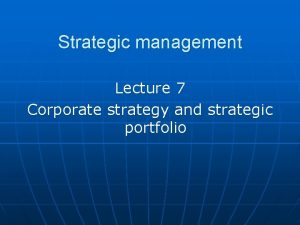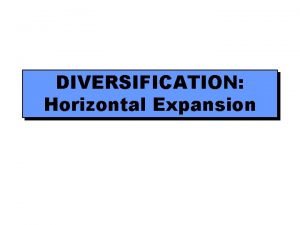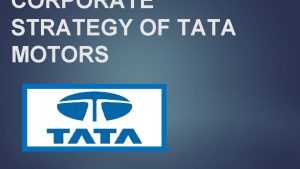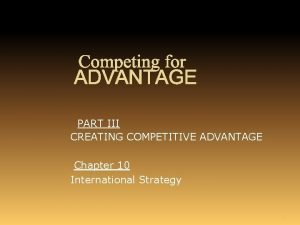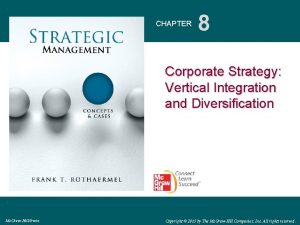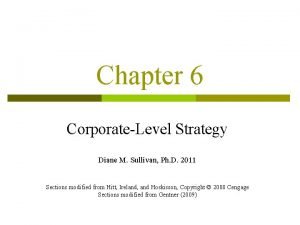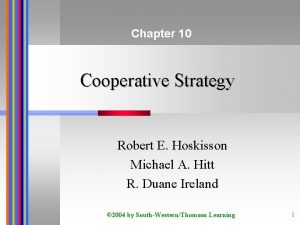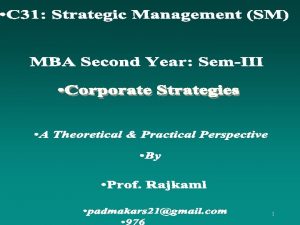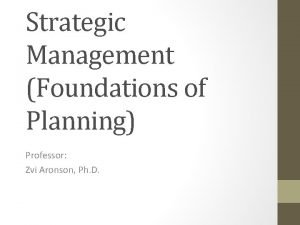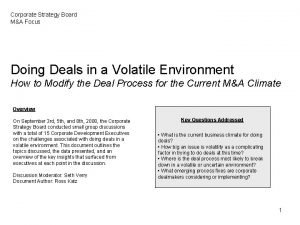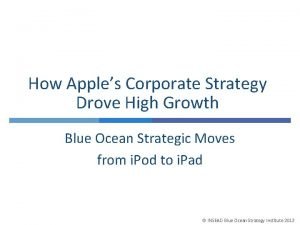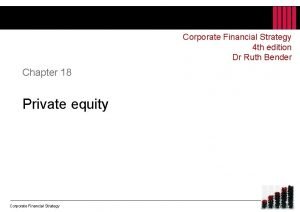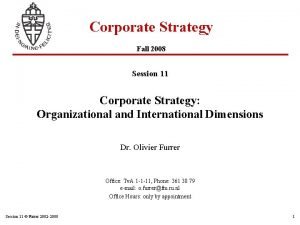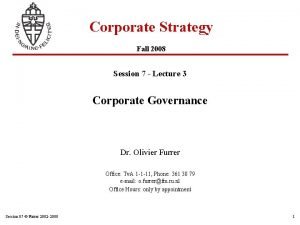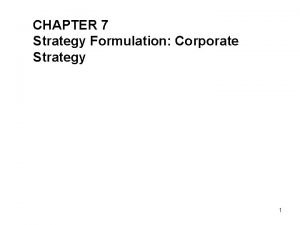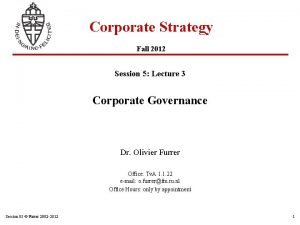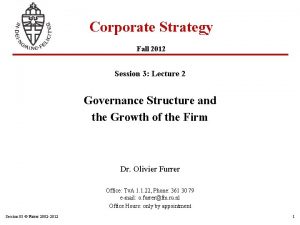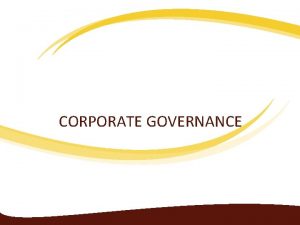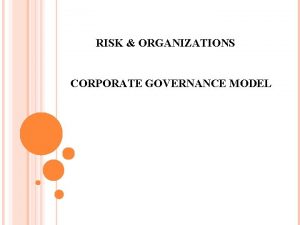Corporate Strategy Fall 2008 Lecture 1 Introduction to





























- Slides: 29

Corporate Strategy Fall 2008 Lecture 1 Introduction to Corporate Strategy with an Historical Perspective Dr. Olivier Furrer Office: Tv. A 1 -1 -11, Phone: 361 30 79 e-mail: o. furrer@fm. ru. nl Office Hours: only by appointment Lecture 1 © Furrer 2002 -2008 1

Discussion Themes 1. Introduction (See Collis and Montgomery, 1997, Ch. 1) – The Need for Corporate Strategy – What is Corporate Strategy? – A Framework for Corporate Strategy 3. Corporate Strategy Analytical Tools (See Collis and Montgomery, 1997, A 1) – Organization Structure and Diversification – Portfolio Planning – Value-Based Strategy – Generic Corporate Strategies – Resource-Based View Lecture 1 © Furrer 2002 -2008 2. An Historical Perspective (See Grant, 2002) – – – Origins of the Modern Corporation The Multidivisional Corporation Postwar Patterns of Diversification The Conglomerates Downsizing, Outsourcing, and Restructuring – Diversification in Emerging-Market Economies – Beyond the Trends 2

Corporate-Level Strategy “Corporate strategy is the way a company creates value through the configuration and coordination of its multimarket activities” Collis and Montgomery, 1997, p. 5 Lecture 1 © Furrer 2002 -2008 3

The Need for Corporate Strategy • Most industrial activity in developed countries is carried out by large corporations which compete in more than one market. • In the United States, 60% of assets are controlled by multibusiness companies (Villalonga, 2003). In Europe, the percentage is about the same (Pedersen and Thomsen, 1997). • On average these firms engaged in over 10 different lines of business. • Due to the dominant role these firms play in economic activity, it is likely that most of you, regardless of their chosen career paths, will at some point either work for, advise, or compete with a multibusiness corporation. Lecture 1 © Furrer 2002 -2008 4

The Need for Corporate Strategy • The nature of these large corporations has undergone enormous change in the last forty years, affecting both their scope and their structure. • The merger and acquisition booms of the sixties and eighties extended the scope of existing multibusiness corporations. • More recently, capital market pressures forced every corporation to reassess its portfolio of businesses, level of overhead, and the way it coordinates and controls its multibusiness activities. • New forms of corporate organization, such has the LBO partnerships of the eighties, provoked a debate about the efficacy of corporate hierarchies. In addition, new institutional arrangements, such as joint ventures, alliances and franchising have come to prominence. Lecture 1 © Furrer 2002 -2008 5

The Need for Corporate Strategy • In response, normative prescriptions for corporate strategy have been varied as the challenges multibusiness corporations have faced. • From an emphasis on financial performances and EPS growth in the sixties, through managing the corporation as a ‘portfolio’ of SBU’s, and searching for ‘synergy’ between business units in the seventies; to the emphasis on ‘free cash flow’ and its corollary ‘shareholder value analysis’ in the eighties, recommendations, such as the strident call to break up corporate organizations or ‘stick to the knitting, ’ have pulled CEO’s in many conflicting directions. • Not surprisingly, only a few corporations have made through the last forty years intact. Of the Fortune 500 in 1950, only 262 firms were still on the list in 1980. Lecture 1 © Furrer 2002 -2008 6

Pressure for Shareholder Value 1970 s: Little – Growth at any cost – Weak rivals – Fragmented, passive shareholders – Ineffective boards 1980 s: Increasing – Restructuring pathological portfolios – Takeover premiums increase Lecture 1 © Furrer 2002 -2008 1990 s: Intense – – – Active shareholders Active boards Global product markets Global capital markets 2000 s: Rethinking – Accounting scandals – Corporate governance (Sarbanes-Oxley Act) – Global markets retreat Ref. : Collis and Montgomery, 2005 7

Corporate-Level Strategy What is Corporate Strategy? Lecture 1 © Furrer 2002 -2008 8

A Diversified Company has 2 Levels of Strategy Business-Level Strategy (Competitive Strategy) How to create competitive advantage in each business in which the company competes - low cost - differentiation - integrated low cost/differentiation Corporate-Level Strategy - focused low cost - focused differentiation (Company-wide Strategy) How to create value for the corporation as a whole Lecture 1 © Furrer 2002 -2008 9

Corporate Strategy Concerns 2 Key Fundamental Questions: What businesses should the corporation be in? How should the corporate office manage the array of business units? Corporate Strategy is what makes the corporate whole add up to more than the sum of it business unit parts Lecture 1 © Furrer 2002 -2008 10

Definition “Corporate strategy is the way a company creates value through the configuration and coordination of its multimarket activities” (Montgomery and Collis, 1997, p. 5) This definition has 3 important aspects: • Value Creation as the ultimate purpose of corporate strategy. • The focus on the multimarket scope of the corporation (Configuration), including its product, geographic, and vertical boundaries. • The emphasis on how the firm manages the activities and businesses that lie within the corporate hierarchy (Coordination). Lecture 1 © Furrer 2002 -2008 11

R ES O U R C ES BU VISION SI N GOALS & OBJECTIVES ES ROLES OF CORPORATE OFFICE STRUCTURE SYSTEMS PROCESSES Source: Collis and Montgomery (1997, 2005) A Framework for Corporate Strategy CORPORATE ADVANTAGE (CA) CA = ƒ (quality of elements, internal & external consistency, mutually reinforcing) Lecture 1 © Furrer 2002 -2008 12

Corporate Strategy: An Historical Perspective • • Origins of the Modern Corporation The Multidivisional Corporation Postwar Patterns of Diversification The Conglomerates Downsizing, Outsourcing, and Restructuring Diversification in Emerging-Market Economies Beyond the Trends Grant, R. M. (2002), “Corporate Strategy: Managing Scope and Strategy Content, ” In Handbook of Strategy and Management, A. Pettigrew, H. Thomas, and R. Whittington (eds. ), London, Sage, pp. 72 -97. Lecture 1 © Furrer 2002 -2008 13

Origin of the Modern Corporation (Chandler, 1977) • The company is a recent phenomenon. Even where economies of scale encouraged larger production units, the limited size of local markets constrained the growth of individual firms. • With the increasing size of firms, management developed as a specialized and professional activity. The modern corporations utilized administrative hierarchies and standardized systems of decision-making, financial control, and information management. These structures enabled companies to expand the size and scope of their activities. • Consolidation through merger and acquisition resulted in the appearance of the first “holding companies” during the late 19 th century. Beyond the appointment of the subsidiary boards of directors, the parent exercised little strategic or operational influence over the subsidiary companies. Lecture 1 © Furrer 2002 -2008 14

The Multidivisional Corporation • The multidivisional corporation was a response to the problems posed by increasing size and diversification both for traditional industrial enterprises and the new holding companies. • The innovators: Du. Pont de Nemours and General Motors in the 1920 s created separate product divisions, each independently responsible for operations, sales and financial performance, leaving to the corporate head office the tasks of coordination, strategic leadership and control. (See Chandler, 1962) • During the next 30 years, the multidivisional structure became increasing prevalent within the US and Europe. Lecture 1 © Furrer 2002 -2008 15

Functional Structure Matrix Structure Network Structure Size of Organization Large Simple Structure Multidivisional Structure Coordination and Control Problems Small Young Lecture 1 © Furrer 2002 -2008 Age of Organization Maturity Ref. : Adapted from Greiner, 1972; Churchill and Lewis, 1983 Strategy and Structure Growth Pattern 16

Functional Structure Chief Executive Officer Finance Production Lecture 1 © Furrer 2002 -2008 R&D Accounting Sales & Marketing Human Resources 17

Multi-Divisional Structure Chief Executive Officer Corporate R&D Division Finance Corporate Finance Strategic Planning Division Production Lecture 1 © Furrer 2002 -2008 Engineering Corporate Marketing Corporate Human Resources Division Accounting Sales & Marketing Division Human Resources 18

Postwar Patterns of Diversification • Not only were companies becoming more diversified, but their diversification strategies progressed from closely-related to more loosely-related businesses, and then towards unrelated businesses (See Wrigley, 1970; Rumelt, 1974). • Tools of strategic analysis developed in the 1970 s and 1980 s permitted standardized yet sophisticated approaches to diversification and resource allocation decisions. These tools included business portfolio analysis (Haspeslaugh, 1983), industry analysis (Porter, 1980), and PIMS models (Buzzel and Gale, 1987). • However, the rise of “professional management” had other implications. The separation of ownership from control encouraged salaried top managers to pursue diversification as a means of growth, often at the expense of profitability (Marris, 1964, cf. Agency theory: Jensen and Meckling, 1976, 1986). Lecture 1 © Furrer 2002 -2008 19

Pattern of Diversification Core Business Closely related businesses Increasingly unrelated businesses Lecture 1 © Furrer 2002 -2008 Source: Collis and Montgomery (2005) 20

Firms Vary by Degree of Diversification Low Levels of Diversification > 95% of revenues from a single Single-business unit Dominant-business Between 70% and 95% of revenues from a single business unit Moderate to High Levels of Diversification <70% of revenues from a single Related-Diversified business unit Businesses share product, techno-logical or distribution linkages High Levels of Diversification Business units not closely related Unrelated-Diversified Lecture 1 © Furrer 2002 -2008 Ref. : Rumelt, 1974 21

Firms Vary by Degree of Diversification 0. 0 Related Ratio: Proportion of a firm’s revenues derived from its largest single group of related businesses. Unrelated Business 0. 7 Dominant. Unrelated Single Business 1. 0 Lecture 1 © Furrer 2002 -2008 Related Business Dominant Business 0. 95 0. 7 Related Ratio Specialization Ratio: Proportion of a firm’s revenues derived from its largest single business. Specialization Ratio 1. 0 0. 0 Ref. : Rumelt, 1974 22

The BCG Matrix Lecture 1 © Furrer 2002 -2008 Ref: Adapted from The Boston Consulting Group, Inc. , Perspectives, No. 66, “The Product Portfolio. ” 1970. 23

Porter’s (1980) Five Forces Model of Competition Threat of New Entrants Bargaining Power of Suppliers Rivalry Among Competing Firms in Industry Threat of Substitute Products Lecture 1 © Furrer 2002 -2008 Bargaining Power of Buyers Ref. : Porter, Michael (1980). Competitive Strategy. New York: The Free Press. 24

The Conglomerates • By the early 1970 s, the emergence of a new type of company with no “core business” and no obvious linkages between their many businesses represented the pinnacle of the diversification trend. • The new conglomerates were of particular interest to finance scholars armed with the tools of modern portfolio theory (Sharpe, 1964, Lintner, 1965). If individual investor could spread risk through diversifying their portfolios of securities, what advantages could the conglomerate firm offer? • Studies of conglomerates have shown that their risk-adjusted returns to shareholders are typically no better than those offered by mutual funds or by matched portfolios of specialized companies (Levy and Sarnat, 1970; Weston et al. , 1972; etc. ) Lecture 1 © Furrer 2002 -2008 25

Downsizing, Outsourcing, and Restructuring • The dominant trends of the last two decades of the 20 th century were “downsizing” and “refocusing” as large industrial companies reduced both their product scope through focusing on their core businesses and their vertical scope through outsourcing. International expansion has continued however. • These changes coincided with a more turbulent environment: the oil shock of 1973 -74, the floating of exchange rates in 1972, the invention of the integrated circuit, and the upsurge of international competition. • The implication seems to be that during periods of market turbulence, the effectiveness of firms’ internal administrative mechanisms is reduced (Cibin and Grant, 1996). In these circumstances, smaller, more focused firms operating close to their markets can be more efficient and effective. Lecture 1 © Furrer 2002 -2008 26

Diversification in Emerging-Market Economies • This refocusing trend is less evident in Asia, Eastern Europe and other emerging market economies than it is in the advanced market economies of North America and Western Europe. • A handful of chaebols continue to dominate the South Korean business sector, while in Southeast Asia sprawling conglomerates have even increased in prominence. • These geographical differences may be partly explained by lack of efficient, well-developed capital markets outside the US and Western Europe, thus offering internalization advantages to diversified companies (Khanna and Palepu, 1997). • Despite the common trends towards diversification and divisionalization across countries identified in the early 1970 s, substantial international differences remain in corporate strategies of large companies. Lecture 1 © Furrer 2002 -2008 27

R ES O U R C ES BU VISION SI N GOALS & OBJECTIVES ES ROLES OF CORPORATE OFFICE STRUCTURE SYSTEMS PROCESSES Source: Collis and Montgomery (1997, 2005) A Framework for Corporate Strategy CORPORATE ADVANTAGE (CA) CA = ƒ (quality of elements, internal & external consistency, mutually reinforcing) Lecture 1 © Furrer 2002 -2008 28

Next Session: Text Discussion 1 Justification for the Multibusiness Firm – Presentations: Williamson (1991); Teece (1982); Montgomery and Hariharan (1991); Jensen (1989). – Write: One-page write-up by group. – Key Questions: • What is corporate strategy? • What are the rationales for the multibusiness firms? • What are the disadvantages for a corporation to be in multiple businesses? Lecture 1 © Furrer 2002 -2008 29
 Corporate strategy and business strategy
Corporate strategy and business strategy Parenting strategy in strategic management
Parenting strategy in strategic management 2008 2008
2008 2008 01:640:244 lecture notes - lecture 15: plat, idah, farad
01:640:244 lecture notes - lecture 15: plat, idah, farad Corporate governance lecture
Corporate governance lecture Corporate finance objectives
Corporate finance objectives Types of organisational strategies
Types of organisational strategies What is corporate strategy in strategic management
What is corporate strategy in strategic management Business strategy evaluation
Business strategy evaluation What is corporate scope
What is corporate scope Corporate level strategy types
Corporate level strategy types Three dimensions of corporate strategy
Three dimensions of corporate strategy Business strategy of tata motors
Business strategy of tata motors Corporate strategy triangle
Corporate strategy triangle A multidomestic corporate-level strategy is one in which:
A multidomestic corporate-level strategy is one in which: Corporate level cooperative strategy
Corporate level cooperative strategy Corporate level cooperative strategy
Corporate level cooperative strategy Corporate strategy
Corporate strategy Taper integration
Taper integration Corporate vs business strategy
Corporate vs business strategy Functional level strategy in strategic management
Functional level strategy in strategic management Corporate level cooperative strategy
Corporate level cooperative strategy Formulating corporate level strategy
Formulating corporate level strategy Types of corporate level strategy
Types of corporate level strategy Zvi aronson
Zvi aronson Corporate strategy board
Corporate strategy board How apple's corporate strategy drove high growth
How apple's corporate strategy drove high growth Three dimensions of corporate strategy
Three dimensions of corporate strategy Corporate financial strategy
Corporate financial strategy Forward integration and backward integration
Forward integration and backward integration







